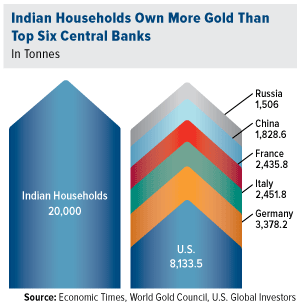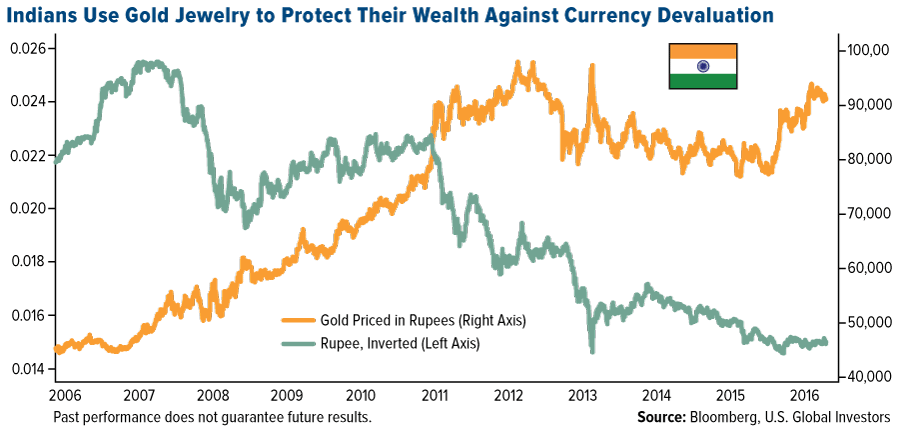The war on cash is still good for gold
The consumer price index (CPI), a measure of inflation, came in hotter than expected Friday, registering 2.3 percent year-over-year in August on expectations of 2.0 percent. With the five-year Treasury yielding 1.19 percent, government bond investors are now receiving a negative real rate of return (because 2.3 minus 1.19 comes out to negative 1.11 percent).

This is highly constructive for the price of gold. As I’ve discussed many times before, the yellow metal has benefited when real rates have fallen below zero. This was the case in September 2011 when gold hit its all-time high of $1,900 per ounce. And last year around this time, the opposite was true—positive real rates were a drag on gold.
Although gold sunk to a two-week low on a strong U.S. dollar and fears over this week’s Federal Reserve meeting, the drivers are firmly in place to push prices higher.

Maybe you’ve heard that a new book out right now is planting propaganda voice in the war on cash. In “The Curse of Cash,” Harvard economics professor Kenneth Rogoff makes the case that nixing paper money—at the very least, larger-denominated bills—“could help more than you might think” in combating criminal activities such as drug trafficking, corruption, extortion and money laundering. It could even prevent the spread of terrorism and discourage illegal immigration, Rogoff argues.
It gets even worse. Central banks, he adds, should have the latitude to drop interest rates below zero during recessions to spur spending. If the Federal Reserve tried this now, of course, many people would likely convert their savings into paper—which at least yields 0 percent—and hoard it in bedroom safes. This is precisely what many Germans have reportedly done, prompting safe manufacturers to scramble to meet demand
But in a world where nothing larger than a $10 bill exists, hoarding cash would be highly impractical. Better to buy that new boat you don’t need!
While we all agree that corruption and terrorism are things that should be stopped, killing cash is the absolute wrong way to go about it.
Instead, perhaps Rogoff should consider “The Curse of No Cash.” Does he not recall what happened in Cyprus just three years ago? The government ransacked citizens’ bank accounts to “fix” its own mistakes and mismanagement. In example after example, people’s rights to save and freely hold cash have been disrupted, with tragic results.
I’ve written about this topic before. In a cashless society, your economic liberty is forever at risk. Every transaction could be monitored, taxed and charged a fee. Capital controls would be crippling, assets could be seized. Just ask the Colombians and Venezuelans
I’m not the only one who disagrees with the ideas in Rogoff’s polemic against money. As of this writing, nearly three quarters of Amazon customers have given the book a rating of two or fewer stars. And in a scathing Wall Street Journal op-ed, respected financial writer James Grant strips away the book’s “technical pretense” to uncover its true motive. Rogoff, he writes, “wants the government to control your money,” which is the extreme form of Keynesian economics.
Gold Has Shined Brightly During Currency Crises
There’s one area where Rogoff and I both agree, though. “As paper currency is phased out,” he writes, “gold prices will rise.” Were cash eliminated and interest rates plunged underwater, gold’s role as a store of value would become even more apparent and demand for the yellow metal would turn red hot, despite its price appreciation.
This has been the case in countless past examples. Rogoff himself cites Indians’ longstanding love of and cultural affinity to gold jewelry as protection against currency uncertainty. For centuries, inhabitants of the Indian subcontinent saw continuous regime change, not to mention imperialist rule by various European forces. During all this time, the one stable and widely accepted currency was gold.
The tradition carries on today. A third of Indian gold jewelry demand comes from rural farmers, who annually convert a portion of their crop revenues into the yellow metal. Whether this gold is stored or given to a female family member, perhaps a daughter, before her wedding day, its purpose is twofold: one, as a beautiful heirloom to be worn and passed down to the next generation, and two, as a form of financial security.
It’s estimated that Indian households currently hold more than 20,000 tonnes of gold. To put that in perspective, 20,000 tonnes is more than the official gold holdings of the U.S., Germany, Italy, France, China and Russia combined.
With speculation strong that a rupee devaluation is imminent, it makes just as much sense now as ever for Indians to have at least some of their wealth in gold. When the rupee unexpectedly dipped to record lows in August 2013, the wealth that prudent Indians had stored in the precious metal was, for the time being, safe.

Although there’s little fear right now that the U.S. dollar is in trouble, I still recommend that investors maintain a 10 percent weighting in gold—5 percent in gold stocks, 5 percent in gold coins and jewelry.
{{ commodity.name }}
{{ post.title }}
{{ post.date }}

Comments